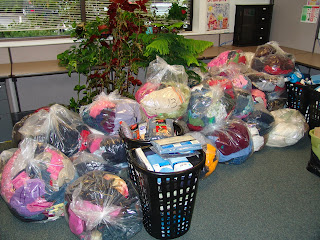I have always appreciated living and working where I do. I think that we are a truly exceptional community. In the aftermath of the recent flooding in our area, the esteem I hold for my community has grown even more. Today I’d like to share a few of the many ways that organizations big and small have reached out to support Imagine! as we work to recover from the disaster.
Big thanks to the
Olive Garden restaurant in Boulder. They contacted us last week to provide a lunch or dinner to some Imagine! folks who have suffered during the flood. Last Thursday they treated Cari Pounds (on the left in photo), who is served by Imagine!, and Direct Care Professional Kristin Conboy (on the right) to a lovely dinner. Kristin and Cari live in Imagine!’s Tenino home, which was damaged by the floods. In addition to the flood damage, Tenino is having its kitchen remodeled (bad timing for sure) so the Olive Garden also donated 12 complete microwavable meals for the next six days!
Two weeks ago, Fred Erlich, CEO of Albany, New York-based
Living Resources (on the right in the picture above) presented me with checks totaling $1,200 to help Imagine! rebuild homes damaged by the recent flooding. The checks were collected from Living Resources staff members, and Fred was out in Colorado to attend a Technology Best Practices Provider meeting hosted by Imagine!, as well as the Coleman Institute for Cognitive Disabilities’ Annual National Conference. I offer my sincere gratitude to our New York friends and partners in using technology to improve the lives of individuals with a variety of disabilities.
I’d also like to offer a hearty “thank you” to the
St. Vrain Flooding Relief Fund for providing Imagine! with a $10,000 grant to help Imagine! cover some of the extraordinary costs incurred during the flooding in our area last month.
The St. Vrain Flooding Relief Fund was established by the
Longmont Community Foundation to provide financial resources to charitable organizations that are involved in the relief and rebuilding efforts in the St. Vrain Valley related to the September 2013 flood.
Imagine! will use the grant to help pay for flooring, drywall, and paint for our Garden Place home.
Thank you for helping us to recover!
The
ANCOR Foundation has provided us with a grant of $6,000 for flood relief. The ANCOR Foundation is dedicated to expanding the commitment and capacity of providers and communities dedicated to improving the quality of life for people with disabilities. We are longtime and proud members of
ANCOR (The American Network of Community Options and Resources) and are so pleased that they are helping to support us in our time of need.
Many thanks are in order for the good people at
Inspiration Field, which serves approximately 200 children and adults with developmental disabilities in the Colorado tri-county area of Otero, Bent, and Crowley Counties.
When they heard about the floods and the impact on folks served by Imagine!, staff members and clients jumped into action, collecting items including gently used, and new, clothing items that ranged from underwear to winter coats to pants to towels, several boxes of toiletries, new hoodies, shirts, goodie bags from Inspiration Field, and $300 in gift cards.
The pictures below show the items, and the first one shows Inspiration Field CEO Johnnie DeLeon, who drove all the way up from La Junta to deliver the goods. Thanks to all at Inspiration Field, you truly inspire us!
This past Wednesday evening, total of $2,262 was raised at a bingo night hosted by the
Denver Metro Young Republicans, the
Colorado Hispanic Republicans, and the
Rocky Mountain Energy Forum. This fundraiser for Imagine! flood relief was held at
Jackson’s Restaurant in Denver. The first $387 was contributed by participants through rounds of bingo, and then a surprise guest, former U. S. Congressman
Tom Tancredo (pictured below with
Imagine! Foundation Executive Director Susan LaHoda), presented a check for $1,875. A big thank you to all who participated and donated!
And here’s one of my favorites. Members of the student council at
Fall River Elementary School in Longmont are organizing a change drive at the end of this month (October 21-November 1) to help raise money for Imagine! flood relief. What a bunch of cool kids! Thanks!
If any of these stories above inspired you, there’s still time for you to help! Today is the last day of our flood relief crowdfunding campaign, which ends at midnight. As I write this post, we are currently at $17,527 or 88% of our goal of $20,000. Thanks to those of you who have contributed personally and those who have passed along the link to the site. We’d love to reach our goal, so we’d very much appreciate it if you would continue to spread the word!!
Or, if you’d like to make a donation, click here. Every little bit helps!



























